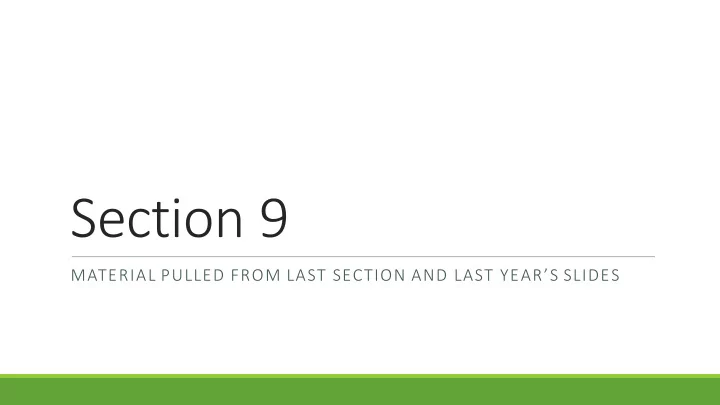

Section 9 MATERIAL PULLED FROM LAST SECTION AND LAST YEAR’S SLIDES
Today’s Agenda Administrivia Review Design Patterns Design Pattern Worksheet Course Review
Administrivia HW9 due tonight at 10PM Friday – Final Exam ◦ In regular lecture room
Design Patterns Creational patterns: get around Java constructor inflexibility ◦ Sharing: singleton, interning, flyweight ◦ Telescoping constructor fix: builder ◦ Returning a subtype: factories Structural patterns: translate between interfaces ◦ Adapter: same functionality, different interface ◦ Decorator: different functionality, same interface ◦ Proxy: same functionality, same interface, restrict access ◦ All of these are types of wrappers
Design Patterns Adapter, Builder, Decorator, Factory, Flyweight, Intern, Model-View-Controller (MVC), Proxy, Singleton, Visitor, Wrapper What pattern would you use to… ◦ add a scroll bar to an existing window object in Swing ◦ Decorator ◦ We have an existing object that controls a communications channel. We would like to provide the same interface to clients but transmit and receive encrypted data over the existing channel. ◦ Proxy
Worksheet time! Solutions will be posted online
Course Review
Stronger vs Weaker (one more time!) Requires more? weaker Promises more? (stricter specifications on what the effects entail) stronger
Stronger vs Weaker @requires key is a key in this @return the value associated with key @throws NullPointerException if key is null A. @requires key is a key in this and key != null WEAKER @return the value associated with key B. @return the value associated with key if key is a key NEITHER in this , or null if key is not associated with any value C. @return the value associated with key @throws NullPointerException if key is null STRONGER @throws NoSuchElementException if key is not a key this
Subtypes & Subclasses Subtypes are substitutable for supertypes If Foo is a subtype of Bar , G<Foo> is a NOT a subtype of G<Bar> ◦ Aliasing resulting from this would let you add objects of type Bar to G<Foo> , which would be bad! ◦ Example: List<String> ls = new ArrayList<String>(); List<Object> lo = ls; lo.add(new Object()); String s = ls.get(0); Subclassing is done to reuse code (extends) ◦ A subclass can override methods in its superclass
Typing and Generics <?> is a wildcard for unknown ◦ Upper bounded wildcard: type is wildcard or subclass ◦ Eg: List<? extends Shape> ◦ Illegal to write into (no calls to add!) because we can’t guarantee type safety. ◦ Lower bounded wildcard: type is wildcard or superclass ◦ Eg: List<? super Integer> ◦ May be safe to write into.
Subtypes & Subclasses class Student extends Object { ... } class CSEStudent extends Student { ... } x List<Student> ls; ls = lcse; List<? extends Student> les; x les = lscse; List<? super Student> lss; x lcse = lscse; List<CSEStudent> lcse; x les.add(scholar); List<? extends CSEStudent> lecse; x lscse.add(scholar); List<? super CSEStudent> lscse; lss.add(hacker); Student scholar; x CSEStudent hacker; scholar = lscse.get(0); hacker = lecse.get(0);
Subtypes & Overriding class Foo extends Object { Shoe m(Shoe x, Shoe y){ ... } } class Bar extends Foo {...}
Method Declarations in Bar • The result is method overriding Object Footwear ↓ ↓ • The result is method overloading Foo Shoe • The result is a type -error ↓ ↓ • None of the above Bar HighHeeledShoe • FootWear m(Shoe x, Shoe y) { ... } • Shoe m(Shoe q, Shoe z) { ... } • HighHeeledShoe m(Shoe x, Shoe y) { ... } • Shoe m(FootWear x, HighHeeledShoe y) { ... } • Shoe m(FootWear x, FootWear y) { ... } • Shoe m(Shoe x, Shoe y) { ... } • Shoe m(HighHeeledShoe x, HighHeeledShoe y) { ... } • Shoe m(Shoe y) { ... } • Shoe z(Shoe x, Shoe y) { ... }
Method Declarations in Bar • The result is method overriding Object Footwear ↓ ↓ • The result is method overloading Foo Shoe • The result is a type -error ↓ ↓ • None of the above Bar HighHeeledShoe • FootWear m(Shoe x, Shoe y) { ... } type-error • Shoe m(Shoe q, Shoe z) { ... } overriding • HighHeeledShoe m(Shoe x, Shoe y) { ... } overriding • Shoe m(FootWear x, HighHeeledShoe y) { ... } overloading • Shoe m(FootWear x, FootWear y) { ... } overloading • Shoe m(Shoe x, Shoe y) { ... } overriding • Shoe m(HighHeeledShoe x, HighHeeledShoe y) { ... } overloading • Shoe m(Shoe y) { ... } overloading • Shoe z(Shoe x, Shoe y) { ... } none (new method declaration)
Exam You got this! We believe in you! Friday (tomorrow) 1:10PM!
Recommend
More recommend